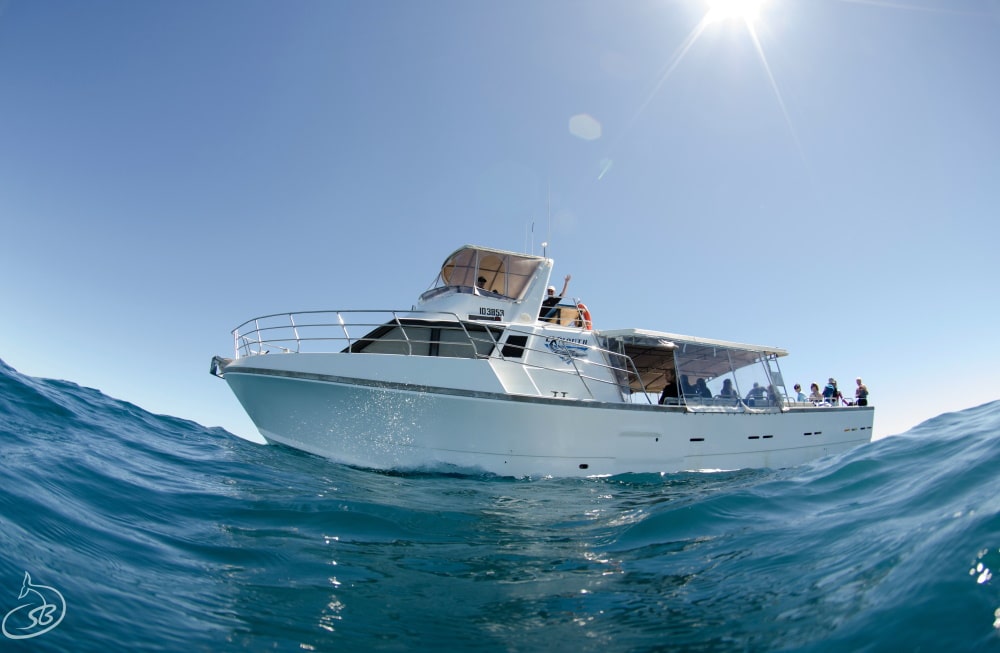Citizen Science, sophisticated dive boats, spotter planes, waterproof radios and years of experience make our humpback swims at Ningaloo unique. Conservation is paramount.
Featured photo: “….two dark ghosts become mighty Humpbacks” (Sara Barbieri – Exmouth Dive)
Imagine this :
You’re out in the Indian Ocean on board a whale-dive vessel. You and seven other “swimmers” sit on the stern dive deck, all set to free-swim with Ningaloo’s mighty Humpback Whales.
The atmosphere is electric…..
1. Training on a purpose-built dive boat

One of Exmouth Dive’s fully rigged, purpose built dive boats. (pic: Exmouth Dive)
In the past few hours, in the safety of the Ningaloo lagoon you’ve been:
- carefully fitted into a wetsuit, facemask and snorkel
- trained — in the water — by expert dive instructors
- testing your gear and strength whilst swimming over the corals and the Delightful little fish of Ningaloo reef.
You’re outside the reef now, over the deep ocean. Your heart races as the tension builds.
Two spouts blow skywards half a kilometre away.
Humpbacks!

Humpback “blow” at Ningaloo – this whale is moving fast (pic: author)
2. A spotter plane appears and the chase begins
Immediately the boat’s engine noise drops from a pounding throb to a soft hum as the vessel moves quietly in the direction of the blows. High overhead a spotter plane glints in the sun.
Its pilot is scanning numerous whales searching for quiet individuals or pods that are safe to swim with. Like humans, each humpback is different.
Boisterous whales can be dangerous and must be avoided. You begin to realise the logistics that are in place to ensure your swim is a success and safe for you and the whales.
As the spotter plane circles tighter overhead the pilot radios your skipper: “Two quiet humpies under me, moving slowly south – good size”. Immediately the skipper changes direction, slows, then cuts the engine; he’s reached the legal minimum drift location 150 metres from the humpbacks.

Exmouth Dive skipper Mark Ferguson speaking to spotter aircraft (pic: Exmouth Dive)
Now it’s your turn to search for the whales.
3. In-water radios
Your dive master slips into the water, your group follows her, heads above the water watching her every instruction. On a waterproof radio she’s receiving instructions direct from the spotter plane, guiding the group closer to the whales.
You can move freely – swimmers are untethered, yet another reason why swimming with humpbacks at Ningaloo is unique.
You drop your head beneath the water and hear the unmistakable song of the humpback. But you can’t see them!
For such a large animal, Humpbacks are not obvious when you’re in the water.
So you wait patiently, hearing the whale song and listening to your dive master’s radio.
She’s performing small miracles: searching for whales, hauling an oversized flotation noodle in case any swimmers need a rest and ensuring no-one gets closer than 30 metres to the whales.
All whilst she’s chatting on the radio — that’s a hell of a job out in the Indian Ocean!

Female Humpback with her youngster – Ningaloo Coast World Heritage Area. (pic: Sara Barbieri – Exmouth Dive)
4. Years of experience and skill pay off
An apparition appears, followed by another. Your eyes focus as two dark ghosts become mighty Humpbacks.
They’re thirty metres away but that’s nothing when you’re swimming with an animal that’s 15 metres long, weighs 30 tonnes and has arms (fins) 4 metres long!
It’s impossible to prepare for this. You force yourself to breathe easy through your snorkel….and Swim With the Humpbacks of Ningaloo…..for as long as they let you.
Because, eventually, they must leave you and continue their 4000 kilometres journey back to Antarctica. They’ve been away from their feeding ground for four months – breeding, birthing and cavorting – and they are seriously hungry.
If you’re lucky you may hear their song fade as they depart.
I guarantee, you will NEVER forget this moment….. in your life….ever!

Humpback in Exmouth Gulf – Cape Range National Park behind (pic: Protect Ningaloo)
5. Wildlife Conservation & Citizen Science
At the core of all Echidna Walkabout’s journeys is a serious conservation ethic. Our unique humpback swim is included as one of the days on this “8 day Island Birds & Humpback” trip to Ningaloo and Exmouth in Western Australia in September.
In this subtropical wilderness you will:
- be involved in purposeful Citizen Science
- help with wildlife surveys on rarely-visited islands in Ningaloo Reef
- count endangered rock-wallabies
- cruise Exmouth Gulf and the Indian Ocean searching for dugongs, dolphins, turtles
- snorkel the magical reefs of the Ningaloo Coast World Heritage Area
We support the conservation efforts of Protect Ningaloo that aim to ensure that the Humpback migration route along the Western Australian coastline remain intact and free from exploitation.
This trip is carried out in collaboration with Exmouth Dive who are deeply involved in protecting Ningaloo Coast World Heritage Area and highly sensitive waters of Exmouth Gulf.
Australian Geographic Travel also supports our conservation work at Ningaloo.
FACTS & INFORMATION
Each August Echidna Walkabout operates our 8 day Island Birds & Humpbacks conservation expedition to the Ningaloo Coast World Heritage Area. This trip is carried out in collaboration with Australian Geographic Travel, Exmouth Dive and Australian Wildlife Journeys.
You can book the trip through Echidna Walkabout or Australian Geographic Travel.
Read more about what we do on this trip:
The surprising wildlife of Cape Range, Ningaloo Australia.
Wild animals of the Ningaloo beaches


